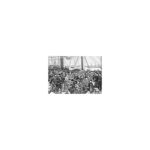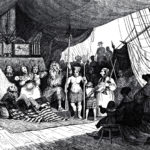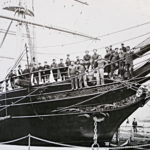On Friday 22 September 1876, James Selwood, his wife Helena, and young Henry boarded the anchored sailing ship Oamaru by way of a tug boat transfer. Everything was hectic as passengers sorted out their bunks and stored their treasures for a new life in New Zealand.
The Oamaru lifted anchor at 4.30pm on Saturday 23 September and, with tug boat assistance, moved out into the Firth of Clyde and set sail for New Zealand.
Here are some facts, figures and highlights about the trip to New Zealand:
- The journey from Scotland to Otago by sailing ship was one of the longest migration voyages in the world (a little longer to Auckland).
- On board were 422 persons, consisting of 372 passengers and a crew of 50.
- There were 339 assisted immigrants, 12 cabin class passengers and 21 steerage passengers.
- Of the assisted passengers, 144 were Scottish, 110 were English, and 85 were Irish.
- There were 51 married men, 51 married women, 97 single men, 62 single women, 61 children and 17 infants.
- James Sellwood, recorded with two “l”s, had an occupation listed as “gamekeeper and agricultural labourer”.
- James and family were assisted immigrants to New Zealand under the Vogel scheme. The emigration cost for the Selwoods was £34 4s 10½d (£13 11s per adult and £7 12s 10
d per child), probably supported by the Campbells.
- The Oamaru set sail from Greenock, Scotland, on 23 September 1876.
- School commenced for the children on 4 October. Some children, even illiterate adults, learnt to read and write on this journey.
- Sunday church services were conducted by the Presbyterian minister, Reverend Bannerman, who was returning to Dunedin. He was of great assistance to passengers, giving information about his sea journey experiences and life in the New Zealand colony.
- On 12 October the Oamaru crossed the Tropic of Cancer, the imaginary line about 22½ degrees north of the equator, where north of it the sun always appears towards the south.
- The equator was crossed on 24 October, 32 days after leaving Scotland.
- The most furtherly west position was reached, at Longitude 31°15’W, on 28 October. The Oamaru was closer to Brazil, South America, by only a few hundred miles, than it was to the African continent. The Oamaru was still moving strongly south but soon turned east with the benefit of the “roaring 40s”.
- On 1 November the Oamaru crossed the Tropic of Capricorn, the imaginary line where south of it the sun always appears to the north.
- For the first 52 days of the journey, the Oamaru was west of its starting point (Longitude 4°77’W) and was still in the Atlantic Ocean. For the next 32 days the ship moved strongly to the east, and south.
- On 13 November the Oamaru passed some 200 miles to the south of South Africa’s Cape of Good Hope.
- Although only 42° south of the equator, an incentive of a bottle of spirits was offered to any passenger spotting an iceberg between 7pm and 7am from 15 November.
- On 25 November snow falls on the deck of the Oamaru.
- The furthest south point, 52°S, is reached on 7 December.
- New Zealand is reached after 83 days of non-stop sailing. Other than the Irish and New Zealand coastlines, the only other land sighted on the journey was San Antonio, part of the Cape Verde Islands, on 13 October.
- Four children died (mainly measles) and four children were born on the trip.
We are so fortunate that on this journey two passengers kept more or less complete diaries of their trip to New Zealand.
One of the diaries was kept by Jane Findlayson, single, 25 years old, from Perthshire, Scotland. She provided a full diary and a wonderful insight into the day by day life on board the Oamaru in the single girls’ section in the stern end of the ship.
The other diary was kept by John McDowell, aged 40, from Antrim, Ireland. He was accompanied by his wife Lucy (36), and two young children, Robert (five) and Henry (four months), and they were bunked in the married quarters of the centre of the ship. He has provided a family perspective with emphasis on the ship and its progress.
We are indebted to these two passengers, and to their families, for depositing their diaries in the Alexander Turnbull Library. With their approval, they are reproduced in the link below. My special thanks to my former student homestay, Jay Lee, now a skilled web site designer, in developing the day by day map showing the movement of the Oamaru and presenting the trip diaries based on the trip coordinates.
Reference:









